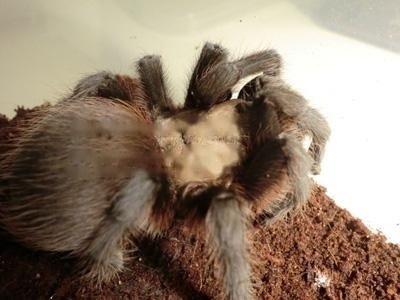
Texas Brown Tarantula
Adult body length is 13-14 cm, suitable temperature is 28-30 ℃, and suitable humidity is 65%. It is recommended to use moist peat, coconut brick and clay as the substrate. It tak
English name: Western Wolf Spider
Personality: Mild
Origin: Mexico
Life: 20+ years
Mexican Goldenback (arantula) is a poisonous The desert-type spider has a lifespan of 29 years. Although venomous spiders are very gentle, more people are willing to keep them as pets . Known as the "Golden Spider".
Chinese name: Mexican goldenback
English name: arantula
Latin name: Aphonopelma chalcodes
Alternative name: Arizona golden wolf Spiders, desert spiders, western tarantulas
Kingdom: Animalia
Phylum: Arthropoda
Class: Arachnida
Order: Arachnids
Family: TarantidaeFamily: Tarantula
Distribution: Sorolla Desert, North America, Arizona, USA , Gulf of Baja California, Mexico
Named and dated: Chamberlin, 1940
In addition to having a particularly obvious golden back on the back of the body, the Mexican Golden Back is also famous for its huge fangs. After being bitten by his fangs, the injured will feel pain and bleeding, and may even be infected.
Mexican goldenback is a species of tarantula spider . 3 to 4 inches (70 to 100 mm) in length, with a life span of more than 20 years, large and robust. Female spiders are usually a single, earthy red in color. Males have black legs and copper-red head, thorax and abdomen. Their burrows can be as large as 1 to 2 inches (25 to 50 mm). This venomous spider from tropical America has huge fangs that it uses to catch birds, rodents and Lizards and more.
Mexican goldenback tarantulas belong to the more primitive Spider. Its body is densely covered with fine hairs, with a kind of irritating short hair. When encountering an enemy such as a mouse, it will use its hind feet to scatter this natural itching powder on the enemy. The reaction of the enemy is like itching all over the body after the worker lays down the woven glass felt. Because they can use this kind of protection, but they may not bite as much as birding spiders in Asia and other places. American bird-catching spiders are often less toxic than those in Asia and other places. The Mexican goldenback is a nocturnal predator and never leaves the burrow unless it is mating season. During winter, their burrows are inserted into soil and rocks, and they live in a relatively dormant state, during which time the animals consume their own fat reserves. The male Mexican goldenback matures at the age of 10 to 12 years, when it leaves its burrow, it will look for a mature female spider, the female spider is at least 10 years old, and the male spider will display the stroking above his burrow like silk cobwebs and expect a female response. During mating, the male spider inserts the vas deferens into the female's genital pore and deposits sperm. The female occupies the burrow because of the eggs to hatch, sometimes leaving the males behind and sometimes driving them away.
Mexican Goldenback's fur is irritating, the main reason for this congenital hair It is to protect the body. When the enemy encounters a natural enemy, he will use his hind feet to sweep away this natural itching powder, causing the enemy to itch instantly.
Mexican goldenbacks typically molt once a year, and whenever a female goldenback molts, it stores sperm in the ectoestrogen (the female reproductive structure). During the summer rainy season (July, August, September) it is usually males looking for mates. Male spiders do not survive long after mating in summer. Sometimes female spiders eat male spiders, or other predators kill male spiders. Male spiders generally live only a few months after mating.
The male Mexican goldenback matures at 10 to 12 years of age, and when it leaves its burrow, it will look for a mature female, which is at least 10 years old, and the male will show himself Above the cave strokes the silky cobwebs and expects a female response. During mating, the male spider inserts the vas deferens into the female's genital pore and deposits sperm. The female occupies the burrow because of the eggs to hatch, sometimes leaving the males behind and sometimes driving them away.